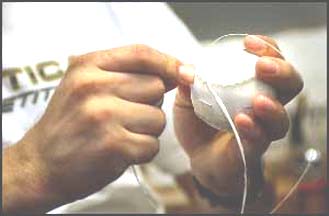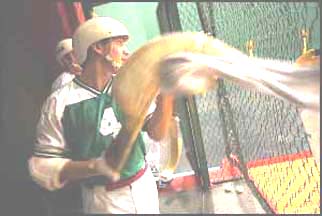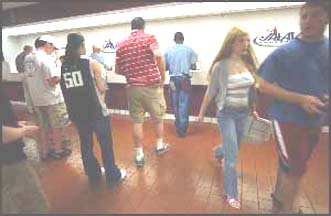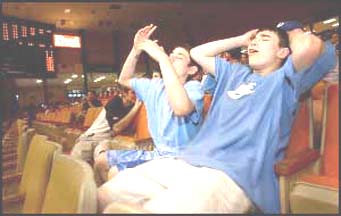 Jai-alai player and pelota maker Manuel Ramirez works on one of the balls at Fort Pierce Jai-Alai & Racebook. The pelota is the hardest and fastest ball used in any sport with a clocked speed of 188 mph. All are hand-made at the fronton, the building in which the sport is played, the ball is constructed of a virgin-de-para rubber core that is covered with heavy duty nylon and then finished with two layers of hand sewn goatskin.
Jai-alai player and pelota maker Manuel Ramirez works on one of the balls at Fort Pierce Jai-Alai & Racebook. The pelota is the hardest and fastest ball used in any sport with a clocked speed of 188 mph. All are hand-made at the fronton, the building in which the sport is played, the ball is constructed of a virgin-de-para rubber core that is covered with heavy duty nylon and then finished with two layers of hand sewn goatskin.
FORT PIERCE — Kathleen Jones looks around the betting concourse at Fort Pierce Jai-Alai.
It's mid-afternoon Tuesday. No live shows, only inter-track wagering. Around her, two dozen patrons, mostly men, mostly her
age, in their mid-50s, silently study racing forms or wall-mounted simulcast screens.
Jones takes a head count. She knows that guy. And that guy. And that woman. Not all by name, she says, but most by face.
"The people here, I've seen the majority of them the last 30 years," she says. "We're like family."
The family — Fort Pierce Jai-Alai — is celebrating its 30th anniversary this year. Jones, now a head teller, has worked at the fronton since the day it opened, May 29, 1974.
"We were known as the friendly fronton," Jones says. "We partied together. We cried together."
There have been no shortage of excuses to do either.
***
The packed auditorium, the buses from Miami every Saturday crammed with fans, the throaty cheers. Javier Hurtado was there. He lived it.
But Hurtado, 56, knows jai alai no longer has the hold on Floridians it did 30 years ago, when he played in Fort Pierce
under the name Romo. The crowds are smaller, the electricity absent. Inter-track wagering — ITW — is now the bigger draw at the fronton.
If only the players hadn't gone on strike for 29 months in the late 1980s, at a time when the new Florida Lottery was changing disposable income spending habits.
But at least players still bind cestas to their hands at 1750 S. Kings Highway and sling pelotas off the wall.
"It's one of the few frontons still open. I'm excited," said Hurtado, now a judge at Miami Jai-Alai. "Because so many of the other ones are gone."
***
The old Tampa fronton on Dale Mabry is now a Home Depot, a Sam's Club and a bank.
Former Indiana businessman W.B. Collett sold the property in 1998 as cracks in the gaming landscape deepened.
"We had to sell Tampa," said Collett, chairman and CEO of Florida Gaming Centers, a venture he began by buying the Fort Pierce fronton in 1993. "It wasn't doing all it could do to maximize its value as an asset."
Collett sold Ocala, too. The four Florida jewels of the former World Jai Alai empire built by Buddy Berenson were down to two: Miami — the flagship, and Fort Pierce, still the moneymaker Berenson foresaw when he concluded growth was inevitable for the Treasure Coast.
Berenson, whose father had opened Miami in 1926, gained control of that fronton in 1965 and bought Tampa about 1970.
The crowds were large then, the handles lucrative. But the season was short, by law. So Berenson found sites for new frontons where his stars could play in the Tampa and Miami offseason.
He found Ocala and Fort Pierce.
***
Kathleen Jones was working for Southern Bell in the early 1970s when a friend showed her a help-wanted ad for a new jai
alai fronton.
"I had never gambled in my life, but anybody who applied got training," she said.
She was trained to be a tele-bet girl. Her job would be to roam the auditorium during games, taking wagers as a convenience
to patrons.
"They were still putting the building together while we were training," she said. "It would rain through the ceiling while we trained."
Construction had begun May 29, 1973, and still wasn't finished on opening day exactly one year later. Fans didn't mind the imperfections.
"They wanted jai alai," Hurtado said.
The 1974 Fort Pierce roster amounted to a Who's Who of jai alai. Asis. Juaristi. Soroa. Irigo. Enrique. Joey, the first
great American-born player.
The Treasure Coast loved them. Even through a change in ownership and state and federal probes, World Jai Alai thrived. Every year, the handles at Fort Pierce got bigger.
The high point for Fort Pierce Jai Alai may have occurred May 29, 1987, the day of a guaranteed rollover pot of at least $50,000.
The records set that day in attendance (3,496) and handle ($339,127) still stand.
"One of my customers bet $25,192," Jones
recalled.
Fort Pierce resident Pete Guettler won $97,345, after taxes, with a $2 bet. He donated it all to St. Anastasia's Church.
To win his bet, Guettler had picked the winners of six games. The last was a doubles game won by Romo.
The Fort Pierce Jai-Alai family had reached the top together. Nobody foresaw the drop.
***
World Jai Alai venues opened the 1988 season offering a new service, sale of tickets to the new Florida Lottery, an
alternative to jai alai for wagering dollars.
Even more ominously, the players formed a union in March 1988 to fight for collective bargaining. On April 14, they began a strike that remains the longest in the history of American sports.
The Fort Pierce fronton closed for two weeks, then reopened with non-striking players and replacements.
Fans saw subpar games. Players reported vandalism. Picketers taunted Jones as she crossed their lines.
"It affected us all," Hurtado said.
Worse than acrimony, the fronton was beset with tragedy during the strike. One player died in a motorcycle accident. The wife and child of another died in an unrelated accident. Two fronton workers died.
"We felt," said Jones, "like there was a big, dark cloud hanging over us."
***
The cloud lifted Sept. 28, 1990. The strike ended.
But the damage was done. People were coming to wager on horse racing simulcasts from Miami, new in 1991, but crowds for live shows were smaller.
"Today, we're still paying for it," Hurtado said.
Soon the new owners added full simulcasts from multiple horse and dog tracks and other frontons. In 2003, its 30th season, Fort Pierce Jai-Alai generated $26.4 million from ITW and $2.5 million from live jai alai.
The days of $97,000 jai alai payouts appear gone.
Yet Fort Pierce Jai-Alai adapts and survives.
Like a family.
"Management's changed," Jones said. "Salaries have changed."
<"But I've always had faith in this place."
- jim.Saturday@scripps.com
If you go:
• What: Fort Pierce Jai-Alai
• Address: 1750 S. Kings Highway, Fort Pierce
• Phone: (772) 464-7500
• Doors open: 11:15 a.m. (11:45 Sundays)
• Admission: $1.50
• Live matinees (noon): Wednesday, Saturday, Sunday (1 p.m.)
• Live evening shows (7 p.m.): Wednesday, Friday, Saturday
• Regular promotions: Free admission for children on Sundays, free general admission for seniors on Wednesday afternoons, free admission/half-price concession on Wednesday evenings, free admission on Saturday evenings
• Season: Jan. 2 - April 30
• Simulcasting/Intertrack wagering: Daily, about 100 screens, from thoroughbred, standardbred and greyhound tracks and other frontons
Fronton timeline
1972
•Aug. 29: Fort Pierce voters approve the proposed fronton 6,632 to 3,356 in a referendum required by state law.
1973
•May 29: Construction begins on the fronton on land at 1750 S. Kings Highway.
1974
•May 29: Twenty days after the planned starting date and at $3 million over the original budget, the $4.3 million Fort Pierce Jai-Alai opens a 109-day season with a matinee at noon and evening show at 7:30.
1987
•May 29: Pete Guettler of Fort Pierce wins $121,681.80 on the first-ever "Super 6 Jackpot" and donates the entire after-tax
take-home total of $97,345 to St. Anastasia's Church.
1988
•March: Players in Florida, Connecticut and Rhode Island form the International Jai Alai Players Association in an effort to collectively bargain.
•April 14: The players strike, citing unfair labor practices.
1990
•Sept. 28: More than two years and five months after the strike began, the sides reach tenative agreement.
1991
•January: The fronton begins simulcasting horse racing from Miami.
1993
•November: Former Indiana businessman W.B. Collett buys the Fort Pierce Fronton from World Jai-Alai Inc. Collett eventually
buys the remaining frontons of the former World Jai-Alai Inc., Miami, Tampa and Ocala, but sells the Tampa and Ocala facilities.
Mid-1990s
•Collett's organization, Florida Gaming Centers, begins offering intertrack wagering and full simulcasts from
throughbred, standardbred and greyhound tracks as well as from other frontons.
 Made of woven wicker reeds, Manuel Ramirez, prepares his cesta before making his way onto the jai-alai court, or cancha, at Fort Pierce Jai-Alai & Racebook. The cestas, used to throw and catch the ball at a high rate of speed, are hand-made to the players specifications on-site and cost around $300 each. Typically, players go through two cestas a month.
Made of woven wicker reeds, Manuel Ramirez, prepares his cesta before making his way onto the jai-alai court, or cancha, at Fort Pierce Jai-Alai & Racebook. The cestas, used to throw and catch the ball at a high rate of speed, are hand-made to the players specifications on-site and cost around $300 each. Typically, players go through two cestas a month.Jai-alai player "Danny," center, hurls the pelota during a game at Fort Pierce Jai-Alai & Racebook. The court on which jai-alai is played is called the cancha and is 178' 8" long, 34 feet high to red foul and 35 feet wide to the 15'6" metal/wood apron. It's a three-sided court with one side open to the public protected by a chain-link fence.
Jai-alai player Ari Mizrachi, 24, of Hollywood, stretches out in the training room before games start at Fort Pierce Jai-Alai & Racebook.
 Those willing to take a few financial risks can place wagers at a betting window at Fort Pierce Jai-Alai & Racebook. Fans have several options when making wagers at the fronton.
Those willing to take a few financial risks can place wagers at a betting window at Fort Pierce Jai-Alai & Racebook. Fans have several options when making wagers at the fronton. During a jai-alai game at Fort Pierce Jai-Alai & Racebook, Matt Witt, 15, left, and David Usiak, 16, of New York, react to action on the court. The fronton, the building in which the sport is played, attracts a diverse group of spectators from families with young children, to men and women of all ages. Witt and Usiak were visiting with their baseball team for spring training.
During a jai-alai game at Fort Pierce Jai-Alai & Racebook, Matt Witt, 15, left, and David Usiak, 16, of New York, react to action on the court. The fronton, the building in which the sport is played, attracts a diverse group of spectators from families with young children, to men and women of all ages. Witt and Usiak were visiting with their baseball team for spring training. Jai-alai player and pelota maker Manuel Ramirez works on one of the balls at Fort Pierce Jai-Alai & Racebook. The pelota is the hardest and fastest ball used in any sport with a clocked speed of 188 mph. All are hand-made at the fronton, the building in which the sport is played, the ball is constructed of a virgin-de-para rubber core that is covered with heavy duty nylon and then finished with two layers of hand sewn goatskin.
Jai-alai player and pelota maker Manuel Ramirez works on one of the balls at Fort Pierce Jai-Alai & Racebook. The pelota is the hardest and fastest ball used in any sport with a clocked speed of 188 mph. All are hand-made at the fronton, the building in which the sport is played, the ball is constructed of a virgin-de-para rubber core that is covered with heavy duty nylon and then finished with two layers of hand sewn goatskin.